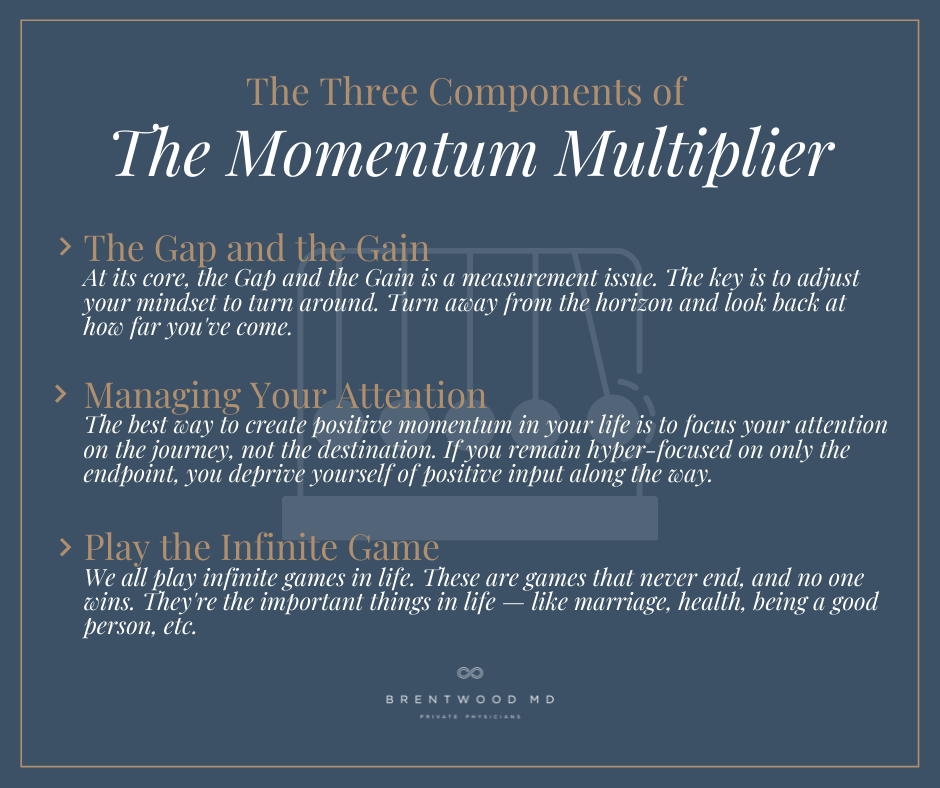Download file | Play in new window | Duration: 00:25:53 | Recorded on January 27, 2022
The new year can be a good time for us to assess the psychology behind resolutions and goals. Famously, it’s a time when people make resolutions they feel will improve their lives.
It’s also, perhaps infamously, a time when many people set ambitious goals they might not reach. Within weeks of the new year, many of us start admitting, “I already broke my resolution.”
This post isn’t about how to follow through on specific goals. Innumerable other blogs exist for that. Instead, I’m excited to share my anti-goal-setting strategy with you. I’ll focus on the (often flawed) mindset around goal-setting and why there’s a better way to build momentum and manifest progress in your life.
I’m a big believer in a concept called the Momentum Multiplier, which I recently discussed on the podcast with Jen Justus and which I’m going to elaborate on here.
I’ll let you in on a secret: people who regularly crush their goals don’t do so because of the nature of the goals they pick or even the game plans they follow to achieve them. It’s because they have the right mindset.
The Momentum Multiplier turns goal-setting on its head so that you focus not on the goal as the destination, but on the journey. The celebration happens during the journey, as we notice our progress, honor who we become, and value the relationships we develop along the way.
There are three actionable components of the Momentum Multiplier mindset: the Gap and the Gain, Managing Your Attention, and the Infinite Game.
Let’s unpack and define these concepts.
The Gap and the Gain
The first component of the Momentum Multiplier is a concept I learned from Dan Sullivan, a strategic coach and entrepreneurship expert. Dan developed an innovative approach, the Gap and the Gain, for reorienting the way we assess and measure individual progress.
We all want to achieve our goals and be happy in life. But if we don’t measure our progress correctly, we won’t notice our gains.
The Gap is the imaginary expanse between where you are now (your current self) and the ideal you’re striving for. But an ideal is not achievable; it’s an ever-moving horizon you can never reach.
And so the Gap becomes the underpinning of the momentum-killing dissatisfaction that plagues so many successful people. No matter how much progress you make, you’ll never be satisfied when you compare it to an ideal.
Instead, however, you can use the horizon (the ideal) to set goals directionally, but you don’t measure against those goals. You measure against where you started the journey. This is the Gain.
The Gain forces you to notice the progress you’ve made. It builds your momentum and unlocks happiness as part of the journey rather than as the result of future goal achievement.
The Gap holds your happiness hostage and leaves you marooned in self-doubt and anxiety. It prevents you from seeing the progress you make on your journey and keeps you fixated on the future.
This is how successful people can remain perpetually unhappy: they measure their value against a future ideal version of themselves instead of appreciating how far they’ve come in their journey of identity and experience.
Measure Correctly To Create Momentum
At its core, the Gap and the Gain is a measurement issue. The key is to adjust your mindset to turn around. Turn away from the horizon and look back at how far you’ve come.
Measuring correctly is measuring yourself by the gains you’ve made along the way rather than by what you’ve yet to do.
Measuring in this way creates a sustainable cycle of positive momentum. By allowing yourself to acknowledge and celebrate the small, consistent wins along the way, you invite happiness into your life, which acts as fuel for more wins in the next phase of your journey.
The Gap and the Gain in Action
To underscore what measuring correctly means, let’s consider a common goal-setting scenario — income — to see the Gap and the Gain in action.
You set a target of earning $200,000 a year. You make incremental progress, but you still feel like a failure when you don’t hit the goal by New Year’s Eve.
The next year, you reach your goal. But cost of living has increased, as have your expenses and recreational spending. You decide your goal really needs to be $400,000. This will allow you to truly be happy.
Measuring forward, across the Gap to the ideal, robs you of any satisfaction in what you’ve gained and leads to a cycle of perpetual disappointment.
Instead of making achieving a financial goal the gatekeeper of your happiness, you can measure backward and allow yourself to notice the gains you’ve made in pursuit of that goal. When I started this journey, I was working 80 hours a week and making $90,000 a year. Now I’m earning three times more for half the work!
The Gain is a much more satisfying place to live. It doesn’t mean you don’t have goals, but that you don’t measure yourself by them. Goals become tools to assist you, not judges to condemn you.
The fulfillment is in the journey. Rather than viewing who you are today as an incomplete version of your future self, measure backward to who you were at the start of this journey. Measuring correctly will allow you to recognize you progress and allow in happiness and satisfaction along the way.
Managing Your Attention
The second actionable component of the Momentum Multiplier taps into the science behind creating positive momentum. It’s a strategic approach of managing your attention.
The core idea at play here is using feedback to better inform your mindset and make micro-adjustments.
Feedback Loops and Momentum
We are biological organisms, and all organisms navigate their existence through feedback loops. A tree, for example, constantly receives feedback from its environment about the optimal angle at which it can get the most sun. It makes little micro-adjustments as it grows, bending this way or that, to reach those warming rays.
Like the tree, we constantly respond to external stimuli in our environments. Our minds process millions of data points each day, absorbing sensory impressions, interpreting them and exporting information back into the world as responses, expressions, behaviors and communications.
When we keep our attention on positive feedback, we lean in and make the micro-adjustments that allow us to reach more of those warming rays. This is positive momentum.

It’s similar to focusing on the Gain. When you recognize your positive progress, you respond with, I had a good experience with that. I should do more of that. It gives you a proverbial tailwind in life, propelling you forward into further positive experiences.
If we only allocate our attention toward the negative, however, we develop momentum in the opposite direction. When your attention remains fixated on the Gap, then the feedback you receive is always negative. It sucks the wind from your sails, leaving you mired and discouraged.
The best way to create positive momentum in your life is to focus your attention on the journey, not the destination. If you remain hyper-focused on only the endpoint, you deprive yourself of positive input along the way.
How To Manage Your Attention
How many times have you found yourself sitting with family or friends only to realize afterward that you didn’t process a word they said? You were preoccupied with a crisis at work, or you were anxious about the future.
Or, perhaps you’ve been fixated on a memory from your past, something you feel negatively impacted your life or derailed your future.
Even social media, television, etc. can absorb your mind. You can unknowingly give away your most precious asset — your attention — to the inconsequential, leaving yourself with little attention for the most important parts of your life.
These things happen to everyone from time to time. But we have to remember, much of the world is out of our control. What we do have control over is our attention. And remember: Whatever has your attention has you.
When your attention isn’t focused on the present — on the moment and place where you are — you rob yourself of meaningful interactions, of that positive feedback that will propel you forward.
Instead, try letting go of the past and of the future. Take your attention off the goal you haven’t reached and the memory that gets your blood boiling. Reserve your attention for right now, today.
Your attention is the highest gift you can give, both to others and to yourself.
Be truly present in your daily experiences and with those you care about. The positive feedback this produces will create increasingly positive momentum in your life.
Play the Infinite Game
The third component of the Momentum Multiplier is a concept introduced by Simon Sinek. It’s called Playing the Infinite Game, but don’t worry, it’s not as abstract as it sounds. In fact, it’s a practical, actionable idea with great utility in building positive momentum.
We all play infinite games in life. These are games that never end, and no one wins. They’re the important things in life — like marriage, health, being a good person, etc.
Infinite games can be frustrating for high-performing individuals who thrive off of conquering obstacles and achieving clear wins. But finite rules don’t apply to infinite games.
The Infinite Game in Action
If you’re looking to “win” an infinite game the same way you’d win a football game or Monopoly, you’re going to be disappointed. There’s no winner at marriage. At health. At any infinite game.
Instead, in an infinite game you have growth. You make progress. And the way you do this is by putting your attention on whatever it is that you want to improve.
For example, if your marriage isn’t where you want it to be, the answer isn’t just scheduling obligatory date nights or doling out prescribed gestures and sentiments. It’s investing your attention in the human you want to connect with.
What you give your attention to grows.
It starts with little, quick wins, which produce that positive feedback and begin to create positive momentum.
Focus on the Journey
The Momentum Multiplier provides three muscles for your lifelong exercise and development. First, you learn to notice when you’re in the Gap and train yourself to quickly get into the Gain. As you make progress, you refine where you put your attention — on the most important things. And as you continue to put your attention on the infinite things, you notice positive progress in those areas.
Setting goals becomes an entirely different process. You put a goal out on the horizon, but it’s only there to direct a process that you enjoy along the way. With a momentum-generating mindset, you use the destination to create the journey.
Don’t miss the journey.
So, moving forward in a new year, try to think of self-improvement not as a frustrating series of discrete goals or finite games but as an exercise in building long-term momentum.
Even if your year doesn’t end up looking exactly how you painted it, if you notice the progress you’ve made from the day or the month before, then your mindset will allow you to be happy and to enjoy the journey.

Dr. Aaron Wenzel is a concierge physician specializing in the care of fast-moving entrepreneurs, executives, and public figures in the Nashville, TN area. Dr. Wenzel’s diverse life experience and extensive training in family medicine, emergency care, nutrition, and hormone replacement therapies give him the unique platform to provide unmatched care for his patients.







